"All customer purchases have important preceding actions, which is why understanding the whole customer journey is crucial..."
As an online automotive parts retailer, you can increase your sales by advertising on Google. But with a wide variety of automotive products available and a diverse range of customer types, it’s crucial to ensure that your Google Ads display to the right people at the right time - and that your ads encourage them to purchase. This blog post explains how car parts retailers should approach Google Ads campaigns.
Who are your customers in car parts retail?
Identifying your target customer group or groups is crucial because it guides the question of your customers' knowledge. Understanding your customers’ level of knowledge will help inform you about what they want to buy and how they are searching for the part they need.
For example, your customer groups might include trade customers, such as specialist technicians of specific marques, through to general car maintenance garages. Alternatively, you might sell to the public, ranging from a driver with basic car knowledge to an expert in a particular car type.
Customer demographic criteria such as their typical age will also impact your product offer, how to advertise to your target customer group, and when.
Take prestige or classic cars - these are more likely to be owned by older customers with more disposable income and time. Conversely, the younger market is typically attracted to lower-value, smaller cars - albeit with potential for conversion and customisation. These groups will not only want different things but will likely search in different ways.

What car parts are you selling?
The selection of car parts for your customer can be complex. For this reason, it’s vital to understand the steps your customer takes, from their first online search through to the payment stage, before they click ‘buy’. If you can achieve this, you’ll be able to engage with them at the right time, with a greater chance of securing the sale.
For some car parts, the customer’s research and purchase process will be more straightforward than for others. For example, when researching and identifying a floor mat set, a shopper’s needs won’t usually involve an exact specification. They might be universal or original equipment according to their vehicle’s make, model and year. But, the customer might only require a few searches before they find what they want to buy.
Other parts, though, can be highly specific according to their mechanical specification. Parts like this might require multiple searches, maybe over multiple days, for the customer to find the part they want and feel confident buying.
Let’s assume the customer wants an Audi A6 TDi ignition, and they begin with that exact search on Google. The results from this first search are highly unlikely to present exactly what they need, so they’ll go on to make a further search.
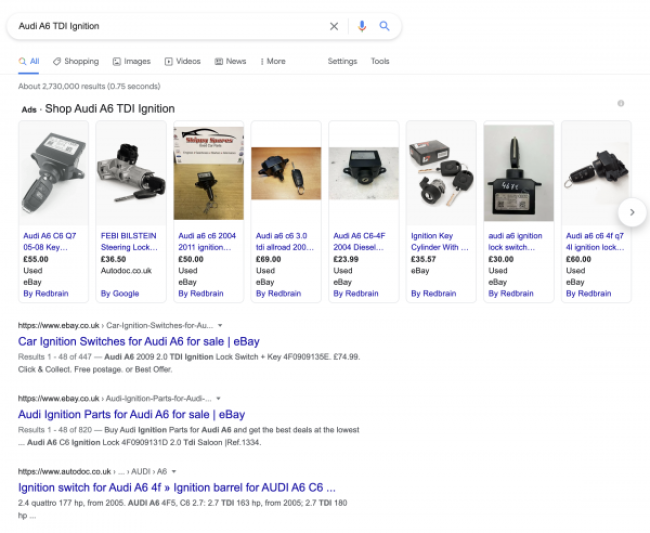
Their next query will be more specific, and they might search for a specific component, such as an ignition switch or coil, adding criteria such as year/version or engine size, therefore creating a ‘long-tail search query.
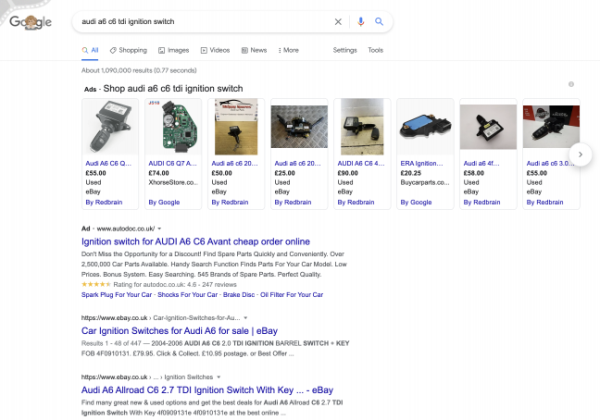
Their searches will get more and more specific until they hone in on the part they want. Generally speaking, the more complex the part, the more complex the customer’s purchase process and, therefore, the more steps of research they will have to take before their purchase journey ends. This is relevant because it helps understand what the customer is searching for and when, and from this, you can formulate a search advertising strategy.

Free Report
Spot Errors, See Strategies,
Our Free Report Reveals Key E-Commerce Fixes.
Book Your Call
What keywords are automotive parts customers searching for?
Understanding the above informs the choice of keywords you should use to ensure your ads are displayed. Keywords, remember, can be individual words or complex phrases. Depending on your target customer, their keywords could be very specific, general, or somewhere in between.
A classic car enthusiast might know the make, brand and part number of the carburettor they require and will search with these criteria, whereas a novice-level owner of a family car might be searching for something as basic as a ‘headlight bulb Ford Mondeo’.
As we’ve already discussed, searches tend to start with more general terms, and as the customer increases their knowledge of the part they need, their search terms become more specific. The more specific their search becomes, the closer they are to purchasing. This process is known as the customer journey.
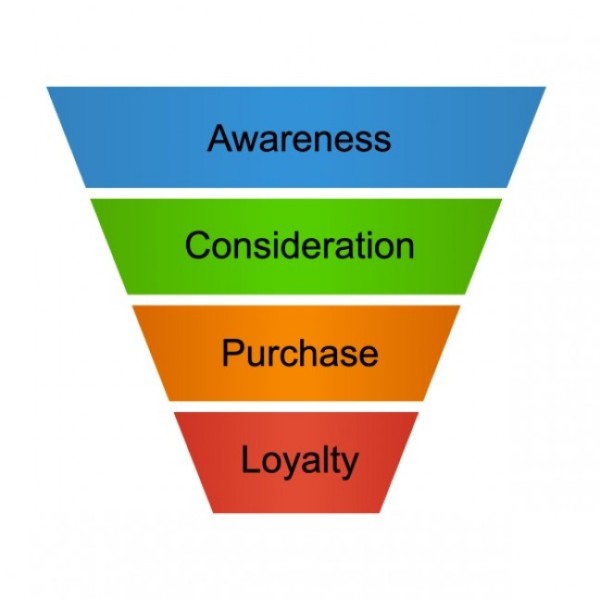
Understanding the stages of your customer group’s journey and the type of searches they are making at each stage will help you identify the keywords you should use to maximise your ad impressions - the number of times your ad displays - and the number of clicks your ad receives.
Qualifying their purchase
Even when the prospect identifies the part specification they need, they will narrow their search further based on attributes such as price and quality. Keywords and content can be used to emphasise these benefits and make a click on your ad more likely, not to mention details of this on the website landing pages to aid purchase decisions, which can only help with conversion rates.
This could include references to warranty or that the part is OE, genuine, or a particular brand. Customers may be searching for a specific brand as they have more confidence with a well-known name, so utilising the value of the brands you sell could help attract more customers.
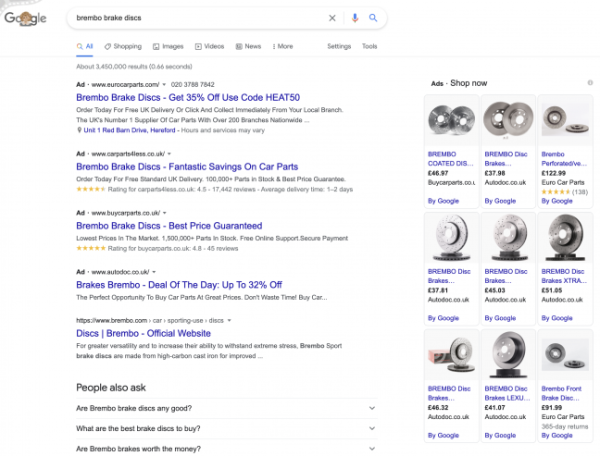
Combining your expert product knowledge with an awareness of your customers can be used to help identify keywords, along with tools that can add data to the process. Google’s Keyword Planner can be used to suggest keywords your market might be using, along with a traffic volume forecast. Third-party software tools can also be used to help pinpoint likely search terms.
Your online advertising strategy for car parts retail
From our review of the customer journey, we know that more specific keyword terms generally have a higher conversion rate, meaning more sales per click. As a result, it’s important to identify and include specific keyword terms as part of your Google Ads strategy.
That said, more general, less specific keywords should also be included in your plan. If a customer has come across your website in a more generic previous search earlier on in the customer journey, they’re more likely to shop with you when they reach the closing stages of their search.
This is because awareness and familiarity generate credibility. Combine this with providing the right information to prospective customers at each journey stage, reinforcing the confidence that they’re buying the right part from the right retailer.
There's less customer risk for a low-cost commodity item, so they might be willing to buy the lowest-cost part from an online motor factor they’ve not previously heard of. But, as the value of the part increases, so does the risk, and the more the potential customer needs confidence in the trader they’re buying from.
Previous confidence-building engagement with the customer can be achieved by advertising for a more generic search that they’ll likely encounter before reaching the purchasing decision stage.

Getting Started With
Performance Max
Download Our Step-by-step guide to getting started with Performance Max Shopping Campaigns for your Shopify Store
GET YOUR FREE EBOOKFREE EBOOK
Keyword budgeting for automotive parts retail
Higher converting keywords will nearly always have a higher cost per click because a click is more likely to return a sale - and your competitors will have identified this, driving the bid price higher. This means you have to commit to a sufficient budget to achieve the required volume of clicks from higher-cost, higher-converting keywords. Failing to do so can mean an underperforming Google advertising campaign.
To guide these budget decisions, it’s worth considering profitability. The keyword cost may be high, but if the spend generates high-volume sales or high profitability from the sale of individual units, the cost of these specific, high-converting keywords will be worth it.
While more generic keywords generally don’t have the same direct conversion success, they are often less expensive. As we discussed, while they aren’t as likely to achieve a converted sale on their own, clicking these lower-cost keywords can increase the chances of a converted sale further along the process.
Investing in lower converting, generic keywords that you identify as relevant to your target customer group should also be included in a well-planned Google Ads campaign.
To learn more about budgeting, read our post about Google advertising: how to set an initial budget.
Where are your customers located?
With local or national deliveries the norm, the location of your customers isn’t usually a significant issue for online car parts sales. However, if your customers like to collect in person, utilising location extensions that appear in Google Maps is useful for local or regional trade. In this case, the customer will also need to know if click and collect is available, store opening hours and onsite parking, so ensure you present this information on your landing page.
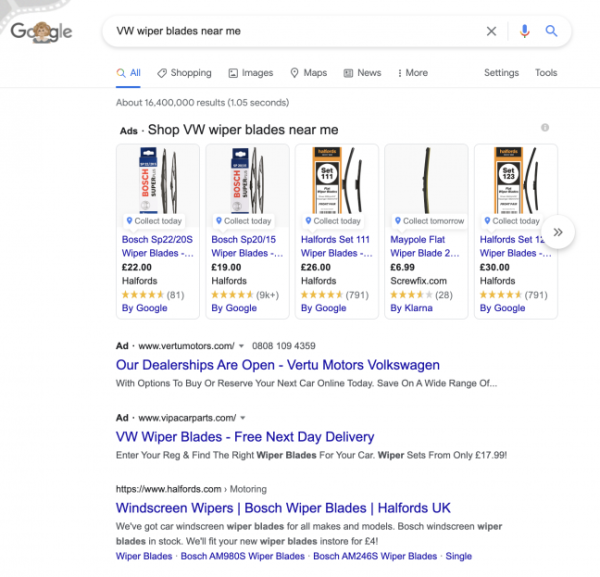
You may have international customers, especially if you manufacture or sell rare or premium parts. In this case, it’s important to assure your customers regarding delivery times and reliability to provide confidence in pre-purchase.
When are you targeting your customers?
As with any online purchase, it’s beneficial that your ads appear when your target audience is most likely to be browsing. With Google Ads, you have control over the times of day your ads will display.
While trade customers could be looking between 9 am and 5 pm, retail consumers might be more likely to search during lunchtimes, evenings and weekends - depending on the demographic. If you trade overseas, this could also mean a different timezone.
Seasonality should also be considered. For example, tyres, batteries and starter motors are a typical focus in colder months, with air-con and radiators in the summer. Your Google Ads campaign should adjust to suit the effective time of year planning.
Which type of Google Advertising should you use for car parts retail?
The most effective choice of Google Ads includes Google Search Network advertising and Google Shopping. Search Network ads include text-based results presented above and alongside normal, non-paid Google search results. Google Search Network advertising involves bidding on keywords and is particularly useful for customers during the earlier research phases involving more general parts searches.
Alternatively, Google Shopping ads display an image of specific products and are shown at the head of some Google search ad results and on the ‘Shopping’ tab on the Google search page. Google Shopping ads operate on a bid to advertise a product type rather than bidding on a keyword.
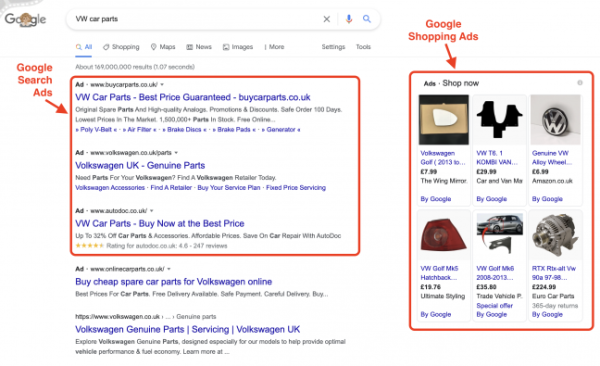
Google Shopping ads are useful to advertise a specific part, enticing viewers with an image and a clear price. Because of their specific nature, they’re beneficial to help convert customers towards the end of the customer journey when they’re closing in on a specific part to buy.
To learn more about Google Shopping ads, read our post: What are Google Shopping ads and why use them.
Landing page and website content for your car parts
When a potential customer clicks on your ad, the landing page they arrive on must be relevant, clear and compelling. The content presented on your landing page must be connected directly to the product the customer is looking for without requiring them to make extra clicks to find it. If the pages of your website aren’t easy to navigate, the customer may well exit your website and try a competitor.
To improve the customer experience and help keep customers engaged with your site, it’s useful to include clear and easy-to-use tools that help guide the customer to the exact part they need. For example, a sizing chart or configurator, including variables such as the car's make, model and year, can aid fast and easy selection of a part. Below is a fine example of how this works, making it easy for users to refine their search, offering confidence they have found the right product.
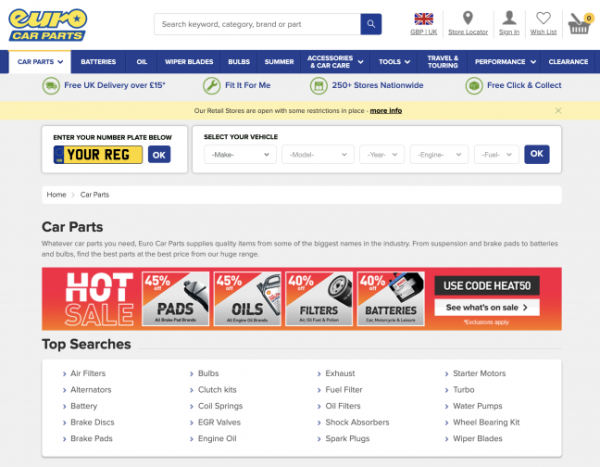
Many customers, especially trade or those from the older age demographic, may be given more confidence by talking to you directly. Clearly displaying your phone number - or hosting an online chat facility - is an open and direct way of helping the customer find what they need.
To encourage the customer through to the final stage to click ‘buy, it’s also important that they have confidence in your payment security and the delivery of your parts, so it’s important to include the necessary authentication and information. Especially for higher-value items, it’s also important to clearly present product returns and warranty information.
Measuring the success of your Google Ads campaign
While sales generated is the ultimate gauge of success, understanding the customer journey is key to developing an effective and cost-efficient Google Ads plan in the long term. For this reason, it’s more effective to set Google Ads’ attribution that shows customer activity from their first click to their last before making a purchase. This will help analyse the customer journey and help you place value on the whole customer journey rather than just the final touchpoint before purchase.
Especially for more complex purchases, the higher up the chain of customer activity you can investigate, the greater your knowledge to influence prospective customers in future.
All customer purchases have important preceding actions, so understanding the whole customer journey is crucial, rather than focussing only on the final customer action. Taken in isolation, the final action looks like it was responsible for securing the sale. In reality, there’s always more to a sale than the final ‘click’.
Want to know more?
The advice in this guide can help automotive parts online retailers plan and implement a more sales-effective and cost-efficient Google Ads plan. It’s based on our experience in the automotive market and improving sales for companies across the UK through Google Ads.
If you would like to know more about how to get the most from your Google Ads campaign, please get in touch.

Book A Discovery Call
Looking for tailor-made PPC strategies? Our team is here to help you maximize your online store's potential. Book a discovery call with us for personalised insights and solutions.
Book Your Free ConsultationBook Your Call